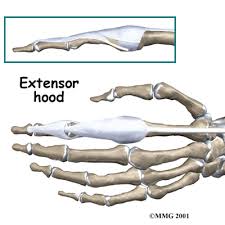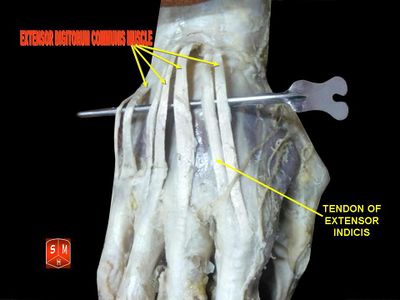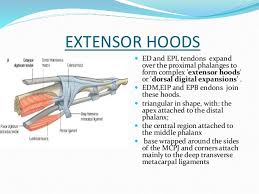Extensor Hood Mechanism Hand: Difference between revisions
No edit summary |
No edit summary |
||
| Line 36: | Line 36: | ||
== Injuries == | == Injuries == | ||
see [[Traumatic Extensor Hood Rupture|Traumatic Extensorhood Injuries]][[File:Extensor hood anatomy.jpg|right|frameless|259x259px]]Injuries to the extensor tendons of the fingers are common because of their poorly protected anatomic location. | see [[Traumatic Extensor Hood Rupture|Traumatic Extensorhood Injuries]][[File:Extensor hood anatomy.jpg|right|frameless|259x259px]]Injuries to the extensor tendons of the fingers are common because of their poorly protected anatomic location.<ref>Radiographics [https://pubs.rsna.org/doi/full/10.1148/rg.233025079 Extensor injuries] Available from:https://pubs.rsna.org/doi/full/10.1148/rg.233025079 Last accessed 18.3.2020</ref> | ||
However Extensor hood rupture is a rare injury associated with boxing and other professional sports. | |||
* Extensor tendon rupture occurs secondary to trauma, inflammatory arthroparthies and steroid injection. | |||
* In boxing, blunt trauma is usually the cause<ref>Pyhsiopedia [[Traumatic Extensor Hood Rupture]] </ref> | |||
== References == | == References == | ||
<references /> | <references /> | ||
Revision as of 07:26, 18 March 2020
Original Editor - Your name will be added here if you created the original content for this page.
Top Contributors - Lucinda hampton, Uchechukwu Chukwuemeka, Kim Jackson, Shaimaa Eldib and Manisha Shrestha
Introduction[edit | edit source]
The extensor hoods are triangular aponeuroses by which the extensor tendons insert onto the phalanges.
- The tendons of the extensor digitorum flatten as they reach the metacarpals and become extensor hoods which fan out and wrap around the metacarpal and proximal phalanx joining onto the palmar plate (structures present on the palmar side of each MCP and interphalangeal joint which limit hyperextension of the digit).
- The extensor hood spreads out further distally into a median band which attaches to the middle phalanx and two lateral bands which attach to the distal phalanx.
- Contraction of the extensor digitorum muscle tightens this tendon which acts on these attachments and extends the fingers.[1]
Anatomy[edit | edit source]
Extensor Hoods are an elaboration of the extensor digitorum comunis (EDC) tendon on the dorsum of each phalanx.
The extensor indicis (EI) and the extensor digiti minimi (EDM) insert into the extensor hoods of the second and fifth digits, respectively.
Several tendinous structures comprise the extensor hoods:
1.The EDC tendon attaches by a tendinous slip to the proximal phalanx, through which it extends the MP joint.
2. The central tendon (or "slip") proceeds dorsally to attach to base of middle phalanx, where tension can extend the PIP joint.
3.The lateral bands proceed on either side of dorsal midline and rejoin before attaching to the distal phalanx. Tension in the lateral bands extends the DIP joint.
4. The extensor hood surrounds the MP joint laterally, medially, and dorsally, and receives tendinous fibers from the lumbricales and interossei.
5. Fibers of the oblique retinacular ligament (ORL) attach at the sides of the proximal phalanx and digital tendon sheaths, and proceed to distal portion of lateral bands. Thus, the ORL's line of application is volar to the PIP joint's lateral axis and dorsal to the DIP joint's lateral axis.
6. Oblique retinacular ligament
PIP extension (produced by other tissues in the extensor mechanism) elongates the ORL, creating passive tension that extends the DIP. The DIP extension helps open the hand.
DIP flexion (produced by the FDP) elongates the ORL, creating passive tension that flexes the PIP. The PIP flexion assists in finger closure.[2]
Injuries[edit | edit source]
see Traumatic Extensorhood Injuries
Injuries to the extensor tendons of the fingers are common because of their poorly protected anatomic location.[3]
However Extensor hood rupture is a rare injury associated with boxing and other professional sports.
- Extensor tendon rupture occurs secondary to trauma, inflammatory arthroparthies and steroid injection.
- In boxing, blunt trauma is usually the cause[4]
References[edit | edit source]
- ↑ Teach me anatomy Structures of the hand Available from:https://teachmeanatomy.info/upper-limb/misc/structures-hand/ (last accessed 18.3.2020)
- ↑ Biomechanics of the hand Gwenda Sharp OTR and Dave Thompson PT Available from:https://ouhsc.edu/bserdac/dthompso/web/namics/hand.htm (last accessed 17.3.2020)
- ↑ Radiographics Extensor injuries Available from:https://pubs.rsna.org/doi/full/10.1148/rg.233025079 Last accessed 18.3.2020
- ↑ Pyhsiopedia Traumatic Extensor Hood Rupture









